
Since I needed a new backpack, a BNSF employee suggested I walk three blocks to Bing 'N' Bobs Sports Shop where I purchased a bright orange one. On the way there, I saw a sign for the Havre Railroad Museum and had time to visit.
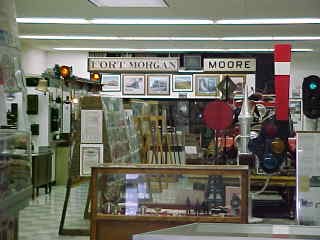
The Havre Railroad Museum, part of the Havre Historical Underground Tours, is located at 120 3rd Avenue (corner of Highway 2 and 3rd Avenue), has an excellent collection of Montana rail lore. After a good visit, I returned to the Amtrak station.
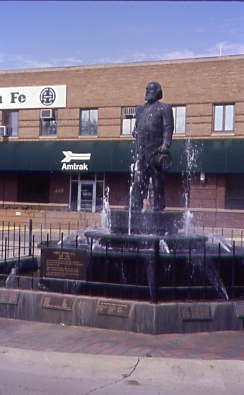
The James Jerome Hill statue, the Empire Builder himself, in front of the station. Born near what is now Guelph in southern Ontario on September 16, 1838, to Irish immigrant parents, young Hill suffered a bow-and-arrow injury at age nine and lost sight in his right eye for the rest of his life. Hill's father died when the boy was 14, so Jim Hill began clerking in local shops before setting off to seek his fortune. He began his career in transportation in 1856 as a 17-year-old clerk on the St. Paul levee.
After 20 years working in the shipping business on the Mississippi and Red rivers, Hill and several other investors purchased the nearly bankrupt St. Paul and Pacific Railroad in 1878. Over the next two decades, he worked relentlessly to push the line north to Canada and then west across the Rocky Mountains to the Pacific Ocean. Renamed the Great Northern Railway in 1890, it remained the "great adventure" of Hill’s life. "When we are all dead and gone," he said, "the sun will still shine, the rain will fall, and this railroad will run as usual."
The 1893 depression saw the collapse of many businesses, including railroads, throughout the United States. Hill took drastic cost-saving measures to keep the Great Northern operating, but the pay cuts to railroad workers proved too much to bear. Workers went on strike that year. Surprisingly, at the end of arbitration Hill accepted most the workers’ demands. It was a notable victory for the young labor organizer Eugene Debs (and occurred a few years before the more famous Pullman strike in Chicago) and marked a significant change in workers' rights.
With the return of prosperity and the wave of trust-building and consolidation in the late 1890s, Hill’s problem became one of how to retain control of his vast railroad holdings. As he bought smaller lines, his wealth and power expanded greatly. Early in 1901 he joined with J. P. Morgan to buy control of the Northern Pacific Railroad — control contested by E. H. Harriman of the Union Pacific in an epic stock market battle in May 1901.
On November 1, 1901, Hill, Morgan, and Harriman announced the formation of the Northern Securities Company, a holding company formed to control the Great Northern, the Northern Pacific, and the Burlington lines. Not for the first time in Hill's career, competitors became partners. The $400-million merger consolidated all major rail lines in the northwest quarter of the nation. The move was politically unpopular and in clear violation of Minnesota statutes. It was immediately challenged in court by Governor Samuel Van Sant. In February 1902, President Theodore Roosevelt began prosecution of the Northern Securities Company under the Sherman Antitrust Act.
At Hill’s insistence, the case was tried in St. Paul at the Federal Courts Building (now Landmark Center). Hill was represented by, among others, the law firm headed by Frank B. Kellogg. The case was carried to the US Supreme Court, and Northern Securities was declared to be in restraint of trade in a 5-4 decision in March 1904. It was a bitter blow to Hill, and the decision marked the role the federal government would often take in breaking up corporate monopolies in the 20th century.
Hill pursued a broad range of other business interests: coal and iron ore mining, Great Lakes and Pacific Ocean shipping, banking and finance, agriculture, and milling. In later years, he explained his economic philosophy in the book "Highways of Progress" and continued the campaign to convert the farmers of the Northwest to the principles of scientific agriculture, often testing breeds of cattle and strains of grain at his own farms.
I went in and met a few of my fellow eastbound Empire Builder passengers before returning outsideof Havre sign.
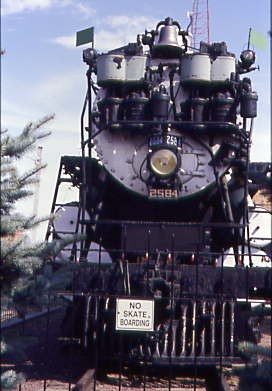
Great Northern 4-8-4 2584 built by Baldwin in 1930. Such Northerns were assigned to the railroad's Montana division working between Williston, North Dakota and Havre, Montana, and the Spokane division for service between Spokane, and Wenatchee, Washington, hauling the Empire Builder and recently inaugurated Minneapolis-to-Seattle Oriental Limited. The S-2s were bumped from the Empire Builder and Oriental Limited in 1949 when the services were dieselised and relegated to secondary passenger and freight trains . During the 1950's, they were all repainted from their original Cascade Green to a more utilitarian black.
2584 was retired from service by the Great Northern in December 1957 and the following year, it was decided to preserve the locomotive for historical purposes. On 15th May 1964, it went on display at its current location.

Later, a colorful BNSF 884 East pulled into Havre.
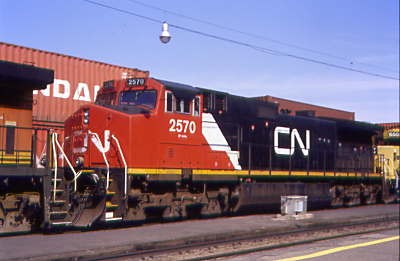
Canadian National C44-9W 2570 built by General Electric in 1997.
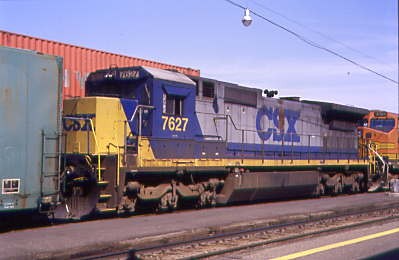
CSX C40-8 7627 built by General Electric in 19909.
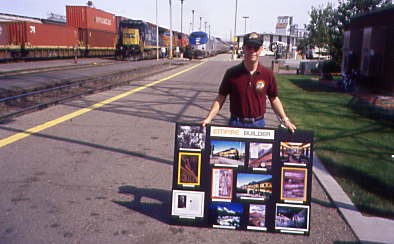
The Empire Builder display board being held by Joe Welsh, who was returning to East Glacier to meet his family there. The Empire Builder arrived at the fuelling racks then the conductor collected my tickets and told me to check with my sleeping car attendant if my room was available.

The train's arrival at Havre.
Empire Builder 7/27 8/22/2005The Empire Builder consisted of P42DCs 130 and 202, baggage 1232, transition 39024, sleepers 32041 and 32054, diner 38050, coaches 34117, and 34133, lounge 33055, coaches 34135 and 31013 and sleeper 32085. We departed on time with me in Room 11 until Whitefish, where I would change to Room 12, and Lathan was my sleeping Car Attendant. I listened to the "Odyssey West" CD that Rob Quist gave me on the eastbound trip this morning. It is a multimedia presentation commemorrating the Bicentennial of the Lewis and Clark Expedition. The music had an even more special feeling as I was hearing it on the Empire Builder, which I hoped will "Roll On Forever!" It is an excellent CD.
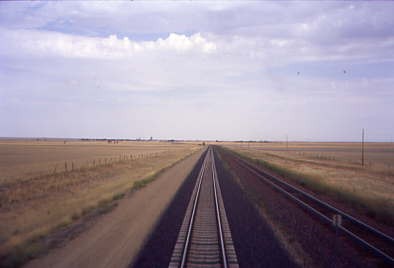
The plains of Montana and Big Sky Country. Later Joe and I had dinner and I had my final Prime Rib on Amtrak until it is cooked fresh onboard again some day. It was horrible and only the chocolate sundae saved my meal. We changed crews in Cut Bank and I asked for my dessert to go so I could resume photography.
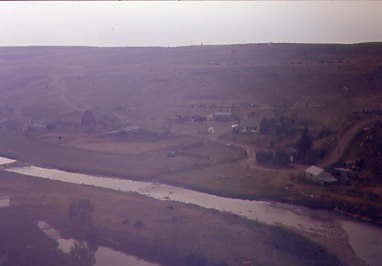
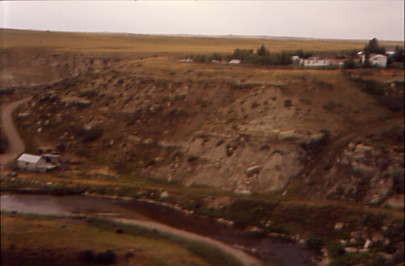
The Cut Bank River west of Cut Bank.

The trestle over the river.

BNSF 7852 West in the siding at Spotted Robe as we neared the Rockies.
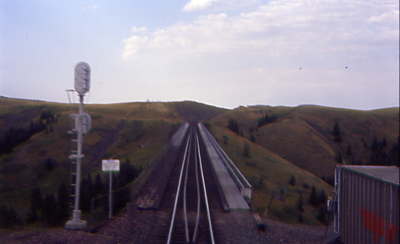
Crossing the Two Medicine Bridge westbound.
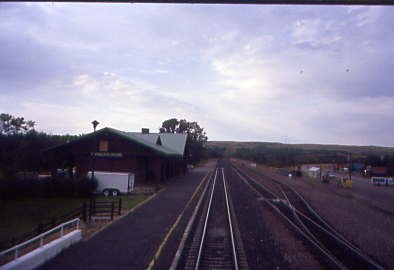
East Glacier after our fresh air stop there.
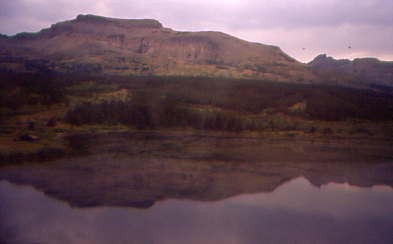
A nice reflection in a pond near Bison. I had a shower and the new door of the refurbished room certainly made it much easier than the old curtains.
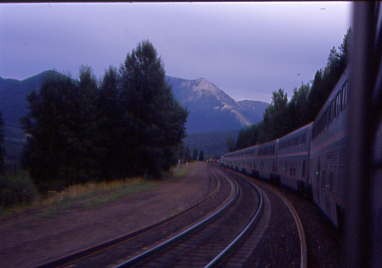
The Empire Builder descended the grade near Blacktail and I really enjoyed the ride through the snowsheds and over the Java High Bridge, which brought back plenty of memories of my trips to the Izaak Walton Inn and railfanning Marias Pass. I waved to the guests on the porch as we passed the Izaak Walton Inn then continued to West Glacier in twilight.
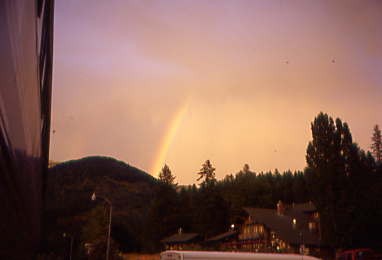
A rainbow greeted our train at West Glacier.
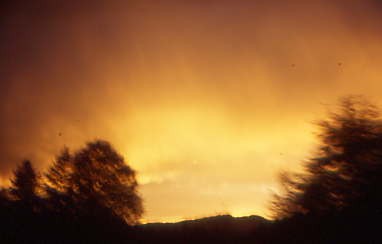
Fantastic clouds as we departed but we waited there for BNSF 7832 East before proceeding to Whitefish, where we arrived at 9:02 PM. I made my switch to Room 12 just as we were pulling in then enjoyed a walk in the night's fresh air and departed on time while I slept the night away.
During the night, the Empire Builder was split per usual practice in Spokane, where half the consist went to Seattle as Train 7 and the other half went to Portland as Train 27. The consist of our Baby Builder was P42DCs 137 and 190, lounge 33055, coaches 34135 and 31013 and sleeper 32085.
8/23/2005 I awoke at Pasco fifty-one minutes late and the conductor informed me that we had met four freight trains between here and Spokane that cost us that time. I said, "Four trains for only 51 minutes. You could wait 51 minutes for one on the Union Pacific." "Really", our conductor said. "You are very lucky to be working on the BNSF", I replied. He just smiled at that thought. I had my breakfast in the lounge car and rode there until Roosevelt.
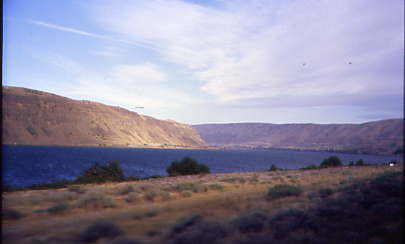
The Empire Builder rolled along the Columbia River.
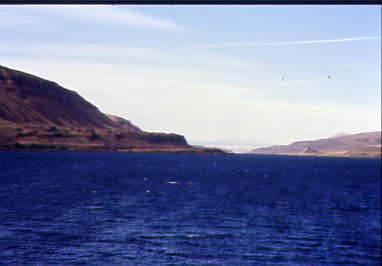
Mount Hood down the river. We had a fresh air stop at the usual very windy Wishram.
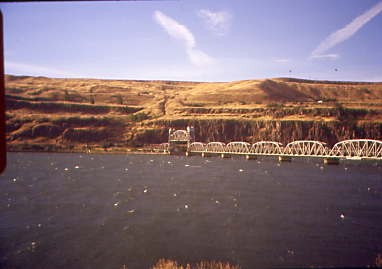
The Columbia River drawbridge on the BNSF Fallbridge Subdivision, which is the north end of the Inside Gateway.
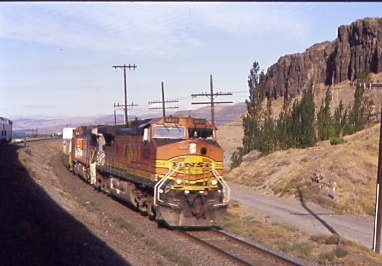
BNSF 4835 East at West Wishram.

Mount Hood behind Hood River, Oregon. After all the pictures I took last month on the Western Star Steam excursion during the National Railway Historical Society convention, I felt as though I did not have to take anymore so soon. We had a beautiful ride through the Columbia River Gorge but exited to cloudy skies in the greater Portland metropolitan area.
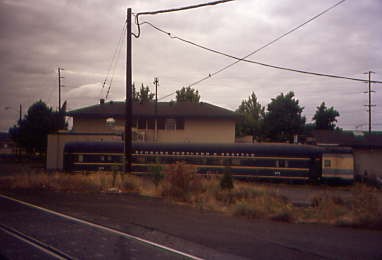
As we approached Vancouver, the railroad cars that make up the 7th Street Restaurant were visible. We stopped at Vancouver then crossed the Columbia River into Oregon, arriving at Portland Union Station at 10:35 AM {10:10 AM}.
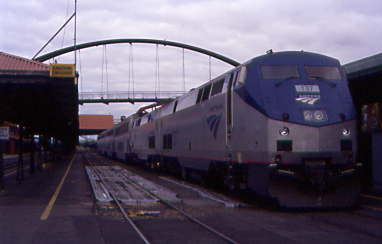
The Empire Builder resting at Portland Union Station.
Portland 8/23/2005I put my luggage in the Metropolitan Lounge and called home, leaving a message. My train to Oakland would not leave Seattle until at least 1:00 PM, since it arrived there at 5:35 AM, nine hours and five minutes late.

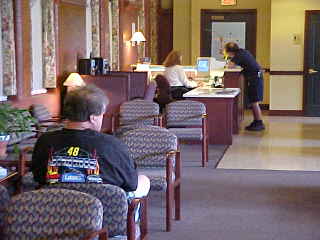
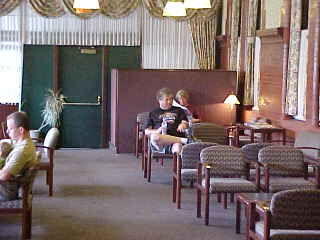
Portland Amtrak's Metropoltan Lounge for all first class passengers.
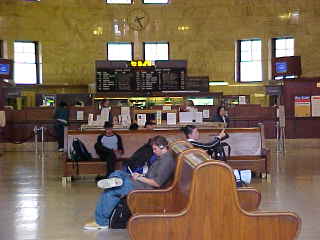
The main hall with ticket office behind.
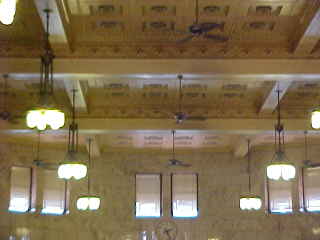
The chandeliers and ceiling.

View into the Waiting Room.
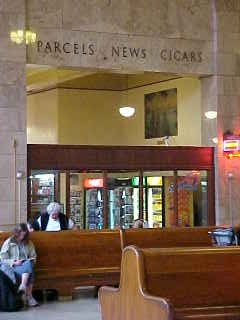
The gift shop. Knowing now I had plenty of time, I walked over to Chinatown and took a MAX Red Line trolley to Lloyd Center and was surprised at what I saw.
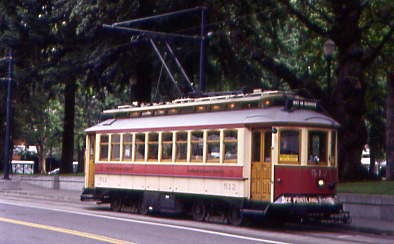
Portland Vintage Trolley 512 built by Gomaco and designed to replicate, as closely as practicable, a design of streetcar which the J.G. Brill Company supplied to Portland in 1904. Those ten cars were originally numbered 201–210, but were renumbered 501–510 in 1905 and kept those numbers for the remainder of their working lives, which ended in 1950 with the abandonment of Portland's last three city streetcar lines.
I asked at the Doubletree Hotel if I could check my e-mail and cleaned it out then went to Radio Shack for some more floppy discs and batteries before having lunch at Arby's then going to the Regal Theater to see Bill Murray in "Broken Flowers". I had to check in my camera due to the theatre's piracy rules. I enjoyed the film and took MAX back to the station, learning that the Coast Starlight would now not arrive until 6:00 PM. After a few telephone calls and relaxing, I walked over to the Portland Streetcar.

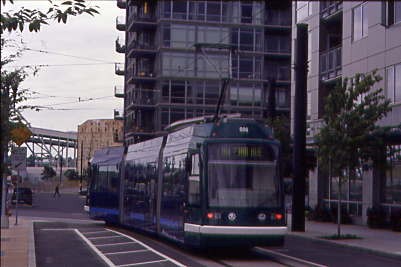
The Portland Streetcar at Lovejoy Station, after which I proceeded to the NW 9th Street grade crossing to wait for the Empire Builder.

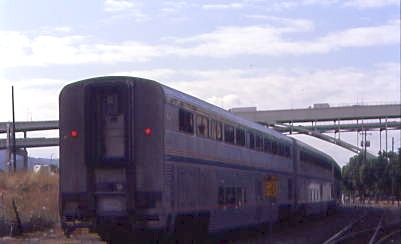
Empire Builder 28 departing Portland Union Station for Spokane and Chicago.
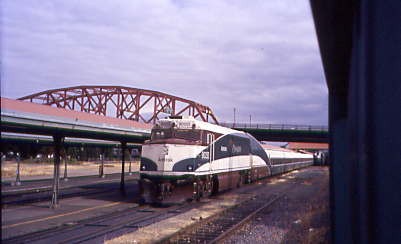
Amtrak Cascades awaiting its journey to Seattle. I returned to the lounge and called Amtrak's automated agent Julie, learning that the Starlight left Seattle at 2:07 PM {10:00 AM} and started to wonder how Fred Dunn's trip went, and found out that he arrived at Oakland at 1:07 PM, four hours behind schedule. Amtrak Cascades 507 arrived on time so I knew we would be following him to Eugene. Our Lounge Attendant told us our train had to be recrewed and 6:35 PM was the new estimated time of arrival. However, that time came and went but a few minutes later, it was announced the train was at NW 9th Street crossing and would be here in minutes. Everyone gathered their luggage and waited by the exit door to the platform.
Coast Starlight 11 8/23/2005The Starlight arrived at 6:47 PM and my Sleeping Car Attendant, Jay, handed me a 6:30 dinner reservation that he had acquired for me. I put my luggage in my room, went straight to the dining car and was seated by Regina and Tish served me. I ordered the lemon pepper salmon which was excellent and we departed at 7:06 PM {2:05 PM} while I enjoyed a chocolate sundae before walking the train. We had P42DCs 57, 119 and 112, baggage 1171, transition 39091, sleepers 32032, 32076 "Delaware" and 32078 "Florida", Pacific Parlour Car 39972, diner 38011, lounge 33030, coaches 34512 Kiddie, 34049, 31000 and 34109; then returned to my room for some Jethro Tull.
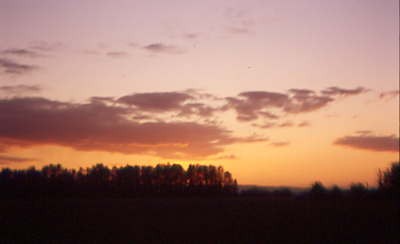
Sunset before Salem. Darkness took hold as three Union Pacific light engines delayed us a few more minutes on our way to Albany. South of there, a dragging equipment detector caught something so our crew had to walk the train. We then met the northbound Coast Starlight, running over seven hours late. I watched some of "Sahara" before we arrived at a very cool Eugene, a nice fresh air stop, from which we departed at 10:30 PM and I called it a night.
8/24/05 I arose just after the Cantara loop and went straight to the dining car for breakfast of French Toast and sausage. We departed Dunsmuir at 6:55 AM {12:35 AM} and that was followed by another daylight trip down the Sacramento River Canyon. At Silverthorn, we went into the siding to wait for the northbound Coast Starlight, which was running five hours late.
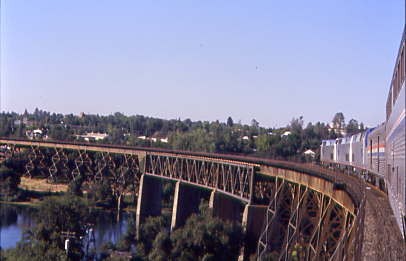
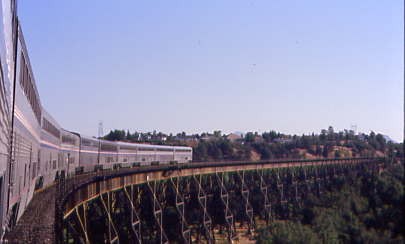
The Coast Starlight crossed the Redding trestle before a very warm fresh air stop at Redding. At Tehama, we had to wait for a track maintenance gang to give us back the railroad, then a non-working detector caused another walking inspection of our train.
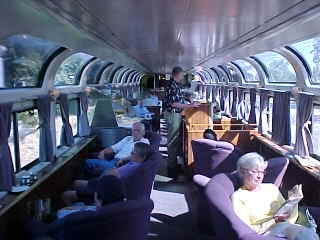
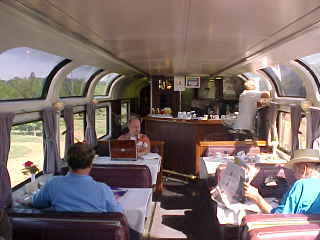
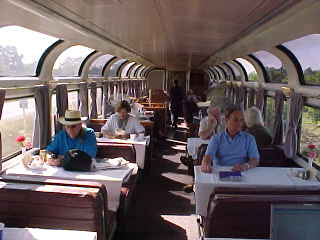

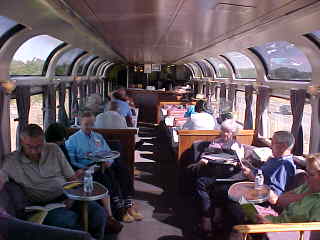
The upper level of the Pacific Parlour Car.
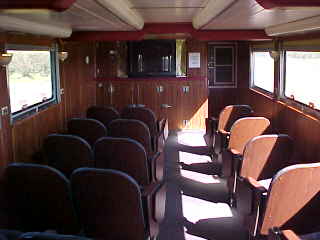
The Pacific Parlor Car theater.
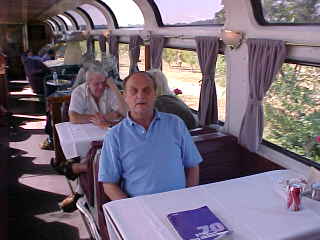
Author Gordon Gill, with whom I spent most of my time talking on this journey.
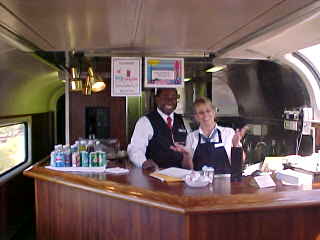
Nanette, our Parlour Car Attendant, along with in-training Larry.
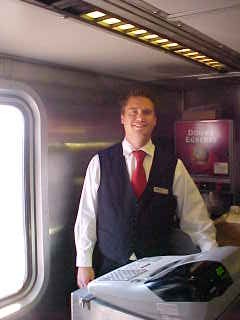
Lounge Car Attendant Aaron Astrup, the always-smiling and pleasant person. We departed Chico at 10:53 AM {3:50 AM} then minutes later, it was announced that this Coast Starlight would be terminating in Oakland and the conductor said would it not be better to get to your destination tonight instead of tomorrow. Train 5's passengers would be bussed to Reno to catch their train, Train 4 passengers would get off in Sacramento to be bussed to Train 716 to Bakersfield and bussed to Barstow. All San Joaquin passengers, as well as all south-of-Los-Angeles Pacific Surfliner passengers, along with those going to Van Nuys, Simi Valley, Oxnard and Santa Barbara, would get off at Sacramento and be bussed to Train 716 to Bakersfield then bussed south.
San José, Salinas, Paso Robles and San Luis Obispo passengers were to stay on the train to Oakland then be bussed to their destination. Myself, as well as anyone going to Davis, Martinez, Emeryville and Oakland would stay on the train to our destinations. I walked back to the Parlour Car to find Gordon to make sure he knew all the details of his trip to Santa Barbara. We rolled off the Shasta Route onto the former Feather River route to Sacramento and I saw my brother Bruce and wished Gordon a safe trip home to Virginia. We departed Sacramento at 1:24 PM {6:35 AM} before proceeding to Davis.
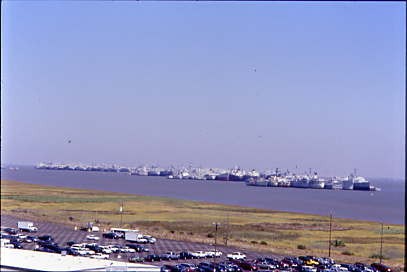
The United States Navy Mothball Fleet was seen before we crossed the Martinez bridge and were dropping into Martinez.

As always, I enjoyed the run along the Carquinez Straits and San Pablo Bay on our way to Emeryville. After we passed the new Amtrak Yard and passed down the street in front of my hotel for the next two nights, we arrived at Oakland at 3:22 PM {8:35 AM}. This ended not only my journey on the Coast Starlight, but the train would stop here as well, as it had been terminated.

The terminated Coast Starlight, however, I knew I would see this same trainset in a couple of hours.
Oakland 8/24/2005I waited at the station to cancel my San Joaquin ticket for tonight that I had purchased before I knew about the Empire Builder trip then walked to the Jack London Inn and checked in, where I checked my e-mail before going up to Room 311 at the rear of the building away from the railroad on the opposite side. I next went out in front of the hotel to catch some rail action and street-running.
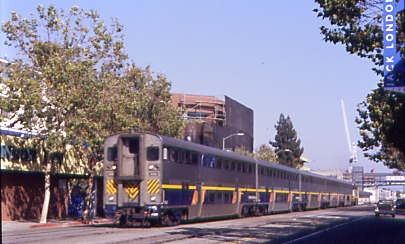
A dead-heading San Joaquin Train 714 returning to the Oakland Amtrak Yard.
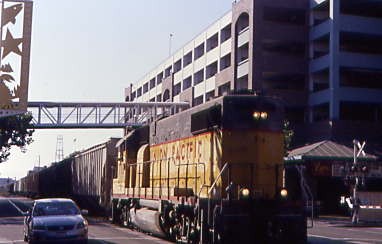
Union Pacific 718 heads to an outlying yard.
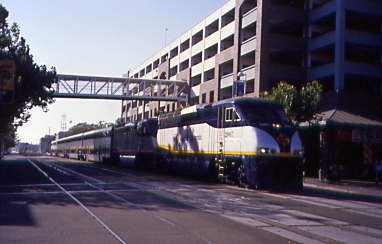
Capitol Corridor Train 541 arriving from Sacramento. I had dinner at the Pizzeria SFO Bar and Grill and enjoyed an excellent steak, but being the railfan I am, brieftly left my table each time the crossing gate bells rang, to photograph the trains.
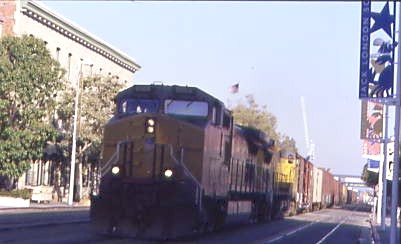
Union Pacific 9564 West through Jack London Square.
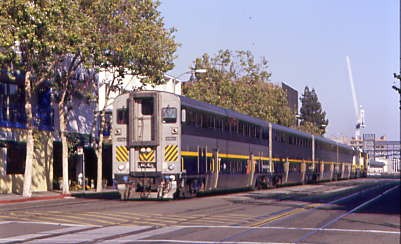
Dead-heading Capitol Corridor Train 541.
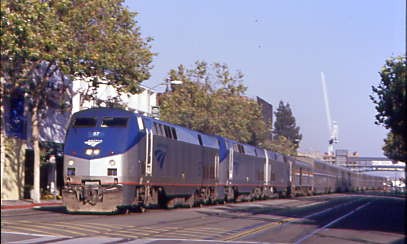

Next here came my Train 11 which ran to Niles Junction and Newark in order to be pointed north. Oakland has no wye long enough to turn the Coast Starlight.
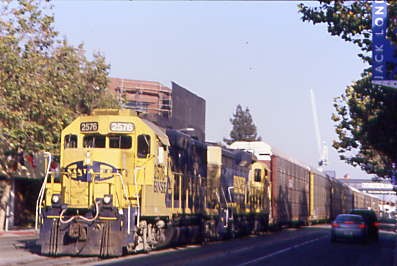
BNSF 2576 East next came by my hotel. I walked to the BART station to learn how to use their ticketing machines and on the way back to the hotel, spotted the former Western Pacific station then called it a night.
Oakland 8/25/2005On the way to the BART station I made a brief detour.
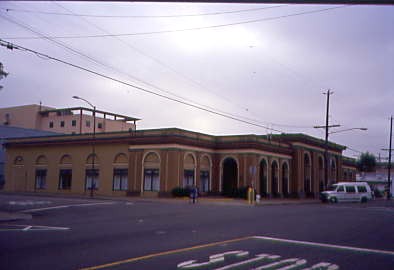
The Western Pacific station built in 1910 and is a Beaux-Arts Classical building. It had a symmetrical front facade, with a tall, projecting, central bay flanked by lower wings. The central bay had a tall attic and paired pilasters trimming either side of three arched entryways. The lower wings also featured arcades trimmed by pilasters. In all cases, the pilasters had plain Doric capitals.
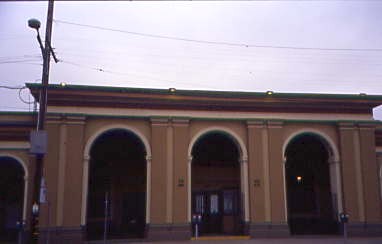
Oakland was the last stop of the original California Zephyr and the earlier Exposition Flyer. The station closed in 1970 with the end of the service. The rails leading into the station were also removed with neighbouring area redeveloped. The building was subsequently sold and converted to a restaurant and multiple other tenants since. In 1974, it was designated the first Oakland Designated Landmark.
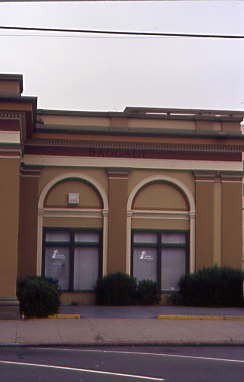
The word "Baggage" gives away its heritage.
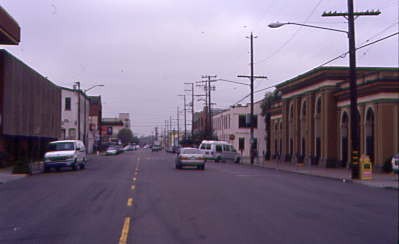
The California Zephyr used to stop right in the middle of the street in front of the station. Now I walked over to the 12th Street BART station to ride their whole system, but that is the next story.
| RETURN TO THE MAIN PAGE |